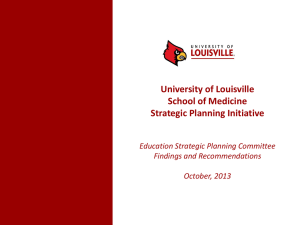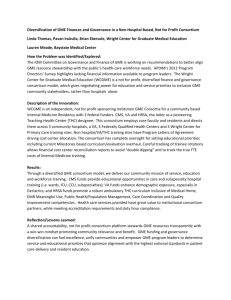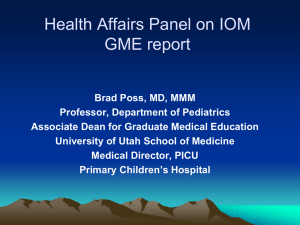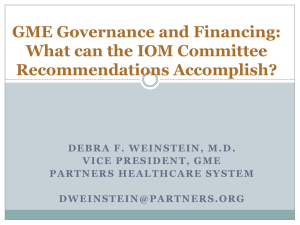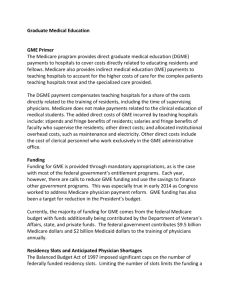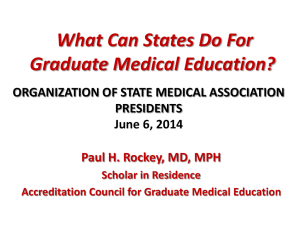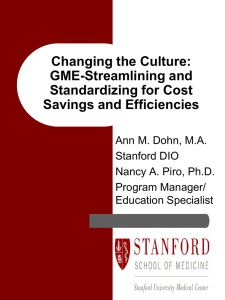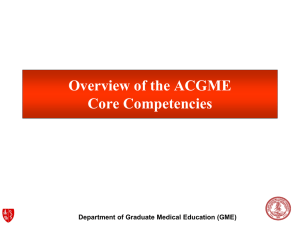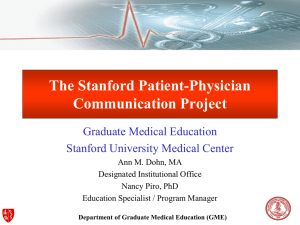GME Outcomes Study - The Robert Graham Center
advertisement
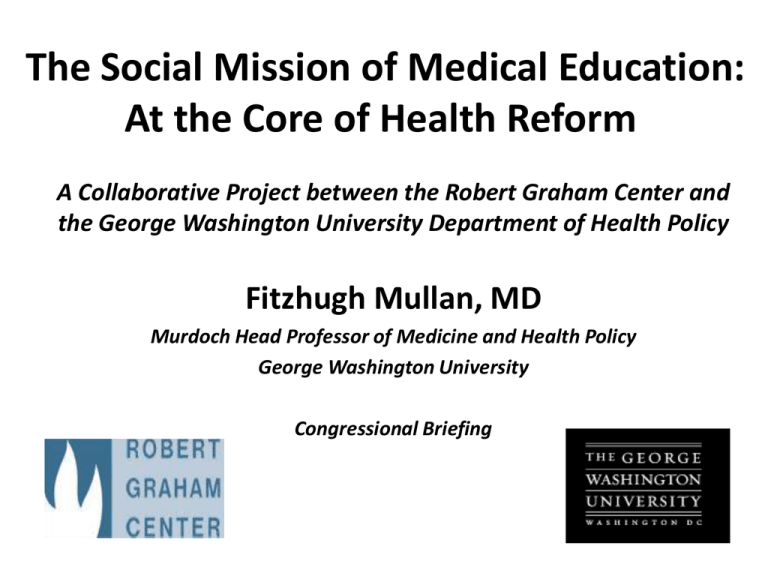
The Social Mission of Medical Education: At the Core of Health Reform A Collaborative Project between the Robert Graham Center and the George Washington University Department of Health Policy Fitzhugh Mullan, MD Murdoch Head Professor of Medicine and Health Policy George Washington University Congressional Briefing July 16, 2013 Social Mission Defined The social mission of medical education is the contribution of a medical school in its mission, programs, and the performance of its graduates to addressing the critical and unmet health problems of the society in which it exists Current Health System Mega-Challenges • Access – 50 million Americans without insurance • Distribution – Huge variation in availability of physicians from area to area • Quality – Systemic problems with quality of care • Cost – Expense of US system is now a drag on national economy Emerging Social Mission Issues in Medical Education • • • • • Health Disparities Social determinants in health Interprofessional education Cost management Generalism • Accountability Original Slide: Federal Funding for Medical Education and Primary Care Social Mission of Medical Education: Ranking the Schools Medical Schools Social Mission Score, Primary Care, HPSA and Minorities Rank School Name State Social Mission Score % Primary Care [std score] % HPSA [std score] URM School State (Nation) State Ratio School (Nation) [std score] URM % URM % 1 Morehouse GA 13.98 43.7[1.20] 39.1[1.40] 3.15[11.38] 83.3% 26.5% 2 Meharry TN 12.92 49.3[2.00] 28.1[0.14] 2.99[10.78] 79.3% 26.5% 3 Howard Wright StateBoonshoft DC 10.66 36.5[0.19] 33.7[0.78] 2.71[9.68] 71.9% 26.5% OH 5.34 49.2[1.98] 28[0.12] 1.31[3.23] 19.0% 14.5% 4 5 KS 4.49 45.2[1.42] 43.9[1.96] 0.77[1.12] 11.6% 15.1% 6 U Kansas Michigan State University MI 4.13 43.6[1.20] 26.5[-0.05] 1.24[2.99] 23.7% 19.1% 7 East Carolina-Brody NC 3.72 51.9[2.36] 34.2[0.84] 0.62[0.52] 17.3% 28.1% 8 U South Alabama AL 3.15 42[0.97] 52.7[2.97] 0.29[-0.78] 8.2% 28.7% 9 Ponce PR 3.02 33[-0.31] 43.8[1.94] 0.84[1.38] 82.5% 26.5% 10 Iowa-Carver IA 2.97 1.35[3.38] 8.1% 6.0% 37.1[0.28] 21[-0.69] Medical Schools Social Mission Score, Primary Care, HPSA and Minorities URM School:State State (Nation) Ratio School (Nation) [std score] URM % URM % State Social Mission Score % Primary Care [std score] % HPSA [std score] 132 Einstein NY -2.13 26.1[-1.28] 24.8[-0.25] 0.33[-0.60] 8.8% 26.5% 133 Stony Brook NY -2.21 29.1[-0.85] 20.4[-0.76] 0.33[-0.60] 10.5% 31.7% 134 Jefferson PA -2.34 32.1[-0.42] 20.6[-0.72] 0.18[-1.19] 4.8% 26.5% 135 Uniformed Services MD -2.36 29.6[-0.78] 21.4[-0.64] .024[-0.95] 6.5% 26.5% 136 UMDNJ-New Jersey NJ -2.46 23.7[-1.61] 17.8[-1.05] 0.54[0.20] 14.8% 27.7% 137 New York University NY -2.65 24.3[-1.53] 22.1[-0.55] 0.34[-0.57] 9.0% 26.5% 138 UC Irvine Northwestern139 Feinberg CA -3.02 32.9[-0.32] 14.2[-1.47] 0.17[-1.24] 7.0% 41.2% IL -3.11 24.4[-1.51] 19.5[-0.86] 0.30[-0.74] 7.9% 26.5% 140 UT Southwestern TX -3.64 26.8[-1.18] 15.1[-1.36] 0.21[-1.09] 9.3% 44.7% 141 Vanderbilt TN -3.95 21.9[-1.86] 20.8[-0.70] 0.13[-1.38] 3.6% 26.5% Rank Sc hool Name • The success of the African American Schools • Public school advantage • Rural advantage • Northeastern disadvantage • Negative correlation between NIH support and social mission score Study Schools • University of Oklahoma-Tulsa School of Community Medicine • Southern Illinois University School of Medicine • Northern Ontario School of Medicine • Morehouse School of Medicine • University of New Mexico School of Medicine • A.T. Still University, School of Osteopathic Medicine in Arizona Social Mission Drivers • • • • • • • • School mission statement Pipeline cultivation Student admissions Structure and content of curriculum Location of clinical experience Tuition management Mentoring and role modeling Preparation for residency Other Social Mission Projects • • • • • • Medical School Mapper Primary Care Physician Mapper GME Outcomes Mapper Teaching Health Centers Evaluation Geography of GME Teaching Health Policy Initiative • GME Accountability Study GME Outcomes Study Candice Chen, MD MPH Assistant Research Professor The George Washington University Methods • • • • • • AMA Physician Masterfile AMA Historical Residency File National Provider Identifier (NPI) File FQHC and RHC Medicare claims, 2009 National Health Service Corps historical file ACGME sponsoring institution/primary training sites data • CMS Hospital Cost Reports, 2008 Methods • Residency Information: – Program name and unique identifying code – Start and end date – Program Specialty • Practice Information: – Specialty – Address • Demographic Information (DOB, gender, IMG) Methods • • • • • • AMA Physician Masterfile AMA Historical Residency File National Provider Identifier (NPI) File FQHC and RHC Medicare claims, 2009 National Health Service Corps historical file ACGME sponsoring institution/primary training sites data • CMS Hospital Cost Reports, 2008 Best/Worst Primary Care production State Grads Spec PC % PC 1. Univ Nevada SOM NY 239 11 129 54% 2. Bronx-Lebanon NY 286 12 143 50% 3. KP South. California CA 286 16 140 49% 4. Brooklyn Hosp Center NY 227 9 109 48% 5. James H Quillen COM TN 240 12 113 47% 157. Vanderbilt TN 793 59 67 8.5% 158. Stanford CA 781 70 65 8.3% 159. Brigham and Women’s MA 893 45 69 7.7% 160. Mass General MA 848 44 55 6.5% 161. Wash Univ MO 1048 72 66 6.4% * Limited to programs with more than 200 graduates between 2006-2008 Best/Worst Rural production State Grads Spec Rural % Rural 1. Univ Puerto Rico PR 343 29 74 61% 2. Geisinger Health System PA 220 21 57 46% 3. Mary Hitchcock Mem Hosp NH 361 37 80 44% 4. Univ of Kansas KS 233 11 46 30% 5. James H Quillen COM TN 240 12 40 29% 157. New York Presbyterian NY 1,599 70 7 1.4% 158. St. Luke’s-Roosevelt NY 529 29 3 1.3% 159. Cedars-Sinai CA 325 27 2 1.2% 160. UCLA Medical Center CA 458 33 2 0.8% 161. Boston Children’s MA 423 29 0 0% * Limited to programs with more than 200 graduates between 2006-2008 and physicians in direct patient care Grads Spec PC % PC Rural % Rural Mount Sinai 1,645 72 430 26% 51 7.6% New York Presbyterian 1,599 70 137 8.6% 7 1.4% Primary Care and Rural Outlook Overall GME Primary Care Production 25.2% Primary Care Physician Workforce* 32% COGME Primary Care Workforce Recommendation* 40% * COGME 20th Report Overall GME Rural Production 4.8% Rural Physician Workforce* 11.4% Rural U.S. Population* 19.2% * Fordyce et al. 2005 Physician Supply and Distribution in Rural Areas of the United States 100 Rural Outcome Relative to Number of Specialties Trained Austen Riggs Center, MA 80 Mercy Medical Center- North IA, IA Location 60 Metro Non - Metro Geisinger Health System, PA 20 40 Mary Hitchcock Memorial Hospital, NH 0 Weighted Mean = 8.5% Weighted Median = 6.3% 0 20 40 Number of Specialties Trained 60 * Limited to Sponsoring Institutions with more than 3 graduates between 2006-2008. ** Puerto Rico institutions are excluded as PR is not included in the rural-urban continuum code designation 80 www.graham-center.org/gmemapper Medical Education Accountability Robert L. Phillips, Jr. MD MSPH Vice President, Research & Policy American Board of Family Medicine Professor, Georgetown University and Virginia Commonwealth University Summary • Measures of Accountability are measurable – They can be modified and updated regularly – Some important limitations, other measures needed • Not producing enough of what we need, where we need them – Not enough to sustain much less meet needs • In the absence of accountability, GME bends to teaching hospital business plan • Listen to Flexner, Coggeshall, IOM, COGME What we Need? • 52,000 more primary care physicians by 2025 – ~8,000 next year due to insurance expansion (more if they don’t go to shortage areas)1 • Medical school output of primary care declined by 20-25% over the last decade • From GME, – ~20% primary care – < 5% going rural – < 5% going into community health centers or rural health clinics Caveats • We over-count generalists – Can’t identify hospitalists – We estimate average ~35% General Internist retention, American Board of Internal Medicine says 17-21%2 • Difficulty with linking ~14% of trainees to primary teaching sites • Difficulty with pure osteopathic training • Related qualitative study of GME Stakeholders – (1)Workforce needs, (2)Training quality, (3)Service – Will be published in September Journal of GME Bending GME to Business 30 Percent Change in Number of PY-1 Available Radiology (25%) 20 Dermatology (40%) 10 Anesthesiology (21%) 0 Ophthalmology (12%) Pediatrics (-8%) Family Medicine (-4%) -10 -20 General Internal Medicine (2%) -30 0 100000 200000 300000 400000 500000 2007 Median Specialty Income Weida NA, Phillips RL Jr, Bazemore AW. Does graduate medical education also follow green? Arch Intern Med. 2010;170(4):389-90. Institute of Medicine The committee recommends an adjustment to the Medicare payment for the direct costs of GME that would create an incentive to establish residencies in primary care and to place those residents in primary care ambulatory settings. • IOM Consensus Report. Primary Care Physicians: Financing Their Graduate Med Education in Ambulatory Settings. January 1, 1989 MEDPAC The Commission recommends – Increasing accountability for Medicare’s GME payments via: • Performance-based incentive program • Publishing Medicare’s payments and teaching costs – June 2010 MEDPAC Report to Congress: Chapter 4: Graduate Medical Education Financing: Focusing on educational priorities. COGME Recommendation: Medical Schools and academic health centers should develop an accountable mission statement and measures of social responsibility to improve the health of all Americans. This includes strategically focusing and changing the processes of medical students and resident selection and altering the design of educational environments to foster a physician workforce of at least 40 percent primary care physicians and a health system that meets societal needs. » COGME-20th Report 2010 President’s Budget From the 2012 HHS Budget Document Better Align Graduate Medical Education Payments with Patient Care Costs: gradually reducing [IME] payments by a total of ten percent, beginning in 2014. Would gives the Secretary authority to set standards for teaching hospitals receiving GME Payments particularly for primary care Coggeshall (AAMC) Report, 1965 “Those responsible for medical education…will, in decades ahead, need to devote careful attention to appraising the needs of society for health care and health personnel and to developing and implementing “Positive assumption of responsibility and plans to meet to those needs. Failure to do so will positive and aloneand – can keep damage theaction standing– of the this profession educational institutions and will invitehands - even make necessary the initiative in the of those best - less desirable approaches to meeting the health care needs to plan the destiny of medical ofprepared a growing America. If those responsible for medical education fail to assume and act on a responsibility that education.” is now clearly theirs, it will be assumed by others.” • Coggeshall, Lowell T. Planning for medical progress through education; a report submitted to the Executive Council of the Association of American Medical Colleges. Evanston, Ill., Association of American Medical Colleges. 1965 Implications • Increasingly difficult to justify GME funding without accountability • We can’t sustain what we have much less meet coming needs • GME can bend back to community/national needs • Good evidence for trainee selection, training content, training location, and incentives • Timely opportunity for policy supporting accountability
